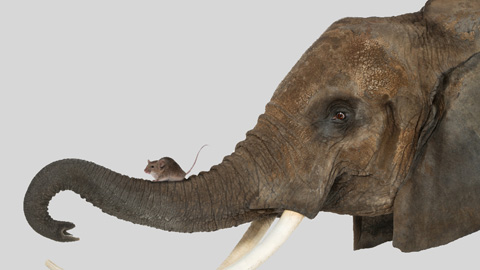Big Data reveals an extraordinary underlying unity in the diversity of life

09/10/2019
The diversity of life is surprising. From microscopic algi to elephants, life has designed innumerable forms to pave its way into all of the planet's environments. Although biologists tend to focus on the many and varied forms of the species which have evolved, the era of big data offers an unprecedented view on some of the surprisingly common characteristics shared by all creatures, both large and small.
A new paper by the Institute of Environmental Science and Technology at the Universitat Autònoma de Barcelona (ICTA-UAB), published this week in the journal PNAS, compiles data from thousands of studies to demonstrate that, despite the infinity of varieties of living beings, many of the most important characteristics of life follow the same universal rules.
The study, directed by ICTA-UAB researcher Ian Hatton, shows how metabolism, abundance, growth and mortality follow extraordinarily coherent relations with body size, from the smallest bacteria to the blue whale.
"The fact that we find these simple mathematical relations spanning across all life forms, points to the existence of a fundamental process at the cores of living systems which we are yet to fully understand", Hatton explains.
Turning Current Theories Upside Down
The study also presents evidence suggesting that one of the leading theories on ecology, the Metabolic Theory of Ecology (MTE), should be reexamined. This theory has played a prominent role in ecology theory, based on the idea that the metabolic rate of an organism is the main limit of many other vital traits, including growth rate.
"One of our key findings is the limits on the speed an organism can grow by, instead of the other way around", says Eric Galbraith, ICTA-UAB researcher and co-author of the study. "This place growth as the main element needed to understand these patterns at a large scale".
Given that growth is the ultimate underlying factor, from youth development to cancer, and from the productivity of resources to the global carbon cycle, understanding growth in general could be of great importance.
"What is surprising is that no matter where you look or what living system you study, everything seems to follow the same rule of growth", says Hatton. "We cannot explain it yet, but we know this has profound implications".
The paper, which also includes co-authors from Princeton University, USA; Charles University, Czech Republic; and the CNRS, France, offers a new perspective on the most fundamental characteristics of life and the extraordinary unity embedded in the diversity of life.
Article:
Ian Hatton, Andy Dobson, David Storch, Eric Galbraith and Michel Loreau, Linking scaling laws across eukaryotes, Proceedings of the National Academy of Sciences, USA. www.pnas.org/cgi/doi/10.1073/pnas.1900492116